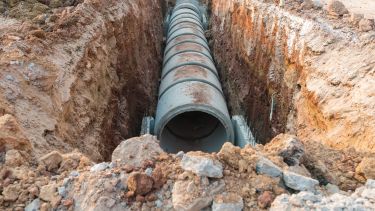How two engineers are solving the UK's number one water quality complaint
It’s a glorious day in June, temperatures are reaching highs of 25°C and the sun is beating down, a rare moment in the UK. The only thing you need is a crisp glass of clean water fresh from the tap. Ordinarily this wouldn't be a problem, but occasionally, like today, it’s a different story.

The warmer temperatures mean everyone has been turning their tap on in the hopes of filling the paddling pool and hydrating themselves and their plants. But this has somehow caused the water to resemble that of a muddy puddle. A problem a pair of engineers at Sheffield are dedicated to solving…
On average, customers report over 90 per cent satisfaction with their water supplies1. Yet discolouration is the number one cause of customer complaints relating to water quality. It’s a problem influenced by an array of factors from where the water comes from, to the water treatment processes and the pipe material itself. Finding a solution to a problem caused by so many interacting factors has seen an array of solutions. But for a pair of engineers the solution was simple: use the forces from flowing water to manage the risks.
Professor Joby Boxall and Dr Stewart Husband are both experts in water infrastructure and the management of drinking water at the University of Sheffield’s Department of Civil and Structural Engineering. Understanding the infrastructure surrounding drinking water and what can cause disruptions to the quality of our precious H2O is essential to making sure it is clean and safe to drink.
In the UK, drinking water is supplied through a hidden network of water pipes. If you put all the pipes in England and Wales end to end you could get that water all the way to the moon. Within it’s a mix of organic and inorganic substances like iron or bacteria essential for life, such as those in yogurt and milk.
Water is clearly not a sterile product, if it was we wouldn't want to drink it, it would taste flat and stale which would be revolting.
Professor Joby Boxall
The University of Sheffield, Department of Civil Engineering
These materials attach to the pipe walls and accumulate becoming an entire ecosystem which can appear as a slime on the pipe wall. Often this process can take years. “When there’s a rapid, increased flow of water through the pipe, like on a hot day when people are using more water, the material can be disturbed back into the water, causing it to change colour,” explains Joby. The result is an unappetising mix with raised levels of chemicals and organic matter.
For a long time the understanding amongst water companies was that pipe deterioration was responsible for the discolouration. So, in a costly attempt to prevent it, they would focus on invasive pipe cleaning methods which requires taking the pipes out of service. Or they’d replace entire networks of pipes especially where there might also be structural or leakage concerns.
In the short term this alleviates the problem, however, it often returns within a few years and the process, we now understand, would have to be repeated. In collaboration with water companies, Joby and Stewart have developed the Prediction and management Of Discolouration in Distribution Systems (or PODDS), a new approach to discolouration - one that’s more than just a pipe dream.
Joby and Stewart’s approach focuses on a process they’ve termed ‘flow conditioning’. To achieve this, the flow of water in a pipe is incrementally increased to gently nudge the slime off the pipe walls and into the flow of water, leaving the pipe in a safe condition for operation.
This controlled increase in flow causes discolouration at a level undetectable to us and is completely safe. The work does not need to be rushed and with careful management and monitoring can be applied over minutes to months depending on the network size. Crucially, it can be repeated whenever it’s needed.
Flow conditioning is conducted alongside normal daily operations, so it’s non-disruptive, no water is lost and evidence can be collected to demonstrate how successful it’s been. With the potential to also be controlled remotely, this effective strategy costs significantly less than other more invasive cleaning methods or pipe replacement.
“Companies don’t need to replace pipes - they can simply manage the risk instead,” says Stewart, “but controlling pumps, or valves and monitoring the flow of water requires planning and the correct infrastructure.” This can present its own challenges, especially in our vital but ageing water distribution systems that are buried underground and easily overlooked.
To try and ease the transition, Joby and Stewart are encouraging the use of monitoring and instrumentation to develop automated approaches. This is exactly what Northumbrian Water have done. “We’ve automated our flow conditioning system across the network so that the flow of water can increase or decrease without manual intervention,” explains Michael Baker, Northumbrian Water’s Tactical Planning Manager.
Northumbrian Water have put the PODDS concepts on to auto. This means the pipes now mechanically condition themselves thanks to the automated system that operates the pumps and valves, allowing technical staff to focus on other responsibilities.
The PODDS team collaborates with water companies across the UK, all attempting to understand the chemical, physical and biological processes that alter the quality of our water. The aim of PODDS is to help companies plan maintenance schedules to prevent discolouration and find a balance between different investment options.
To do this they’re now attempting to understand the rate material can accumulate and the factors affecting these rates. Factors like the effectiveness of advanced treatment processes to control organic content or manganese concentrations, and the impact of different pipe materials and conditions.
These robust layers of micro-organisms and inorganic substances will always form inside these vast aquatic networks, after all, it is a living ecosystem. But while water companies are forming collaborations with researchers like Joby and Stewart, hopefully we can continue to live in harmony with this engineered environment and not have to be concerned with murky water pouring from the tap.
By Alicia Shephard, Research Marketing and Content Coordinator
1 - https://discoverwater.co.uk
Download a summary of the Management of Discoloured Drinking Water (PDF, 3.4MB)
Further information
Research publications
Derivation and Validation of a Leakage Model for Longitudinal Slits in Polyethylene Pipes
Find out more
PODDS
For further information contact:
Sean Barton
Media Relations Officer
University of Sheffield
0114 222 9852
s.barton@sheffield.ac.uk



